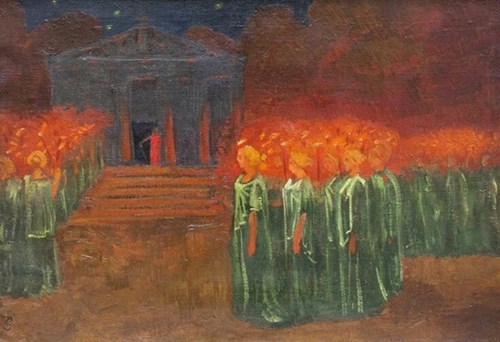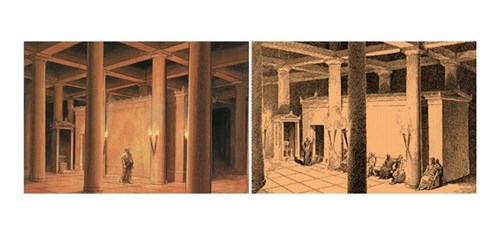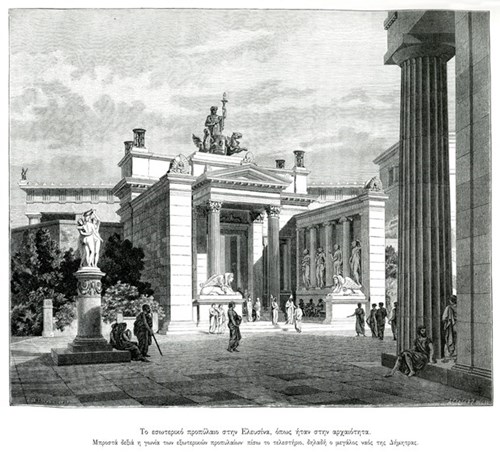The Great Light
Entering the Telesterion was a stunning moment for the initiates. After all these weeks of preparation, it was finally time to become acquainted with the most profound secrets of Demeter’s rituals. Unfortunately, we know very little about what happened inside the Telesterion. Still, Plutarch preserves the breathtaking atmosphere inside the temple when the faithful crossed its doors: “But then one encounters an extraordinary light (φως τι θαυμάσιον) and feels pure regions and meadows offering welcome with voices and dances and sacred sounds and sights (φάσματα άγια)”. An initiate seemed equally impressed with this miraculous light and used a statue base to recall the “nights shining with the beauty of the sun”.

The source of this blazing light is a minor mystery within the more expansive secrecy that shrouds most aspects of the Greater Mysteries. An open fire inside the Telesterion would have to be tremendously strong and bright to inspire these feelings of awe. The hierophant and his assistants would run the risk of being roasted alive, and the night would turn into a holocaust, much like that fateful day in late summer 170 CE when the Costobocs burned down the sanctuary. It is, nevertheless, beyond question that the light played a crucial part in the ceremony and served in a proverbial setting. Galen swears by the “fire of Eleusis” (εν Ελευσίνι πυρ) while Euripides calls Persephone “mistress of the fire” (σὺ δ᾿ ὦ πυρὸς δέσποινα Δήμητρος κόρη).

The lament of a father who lost his child prematurely may hold the solution to the mystery. The Greek sophist and rhetorician Himerius (c. 315 - 386) had the misfortune to experience the death of his son, Rouphinos. The child was about to participate in the Mysteries as a Hearth Initiate, a great honour for himself and his family since he would serve as the state’s official representative to the initiation ceremony. Himerius would serve as the mystagogue, but Demeter and Kore had different plans, and young Rouphinos perished before his initiation in Eleusis. The grief-stricken father composed a lament and referred to his child’s inability to “gaze upon the fire of torchbearers,” having instead to look at the “torches of the Erinyes and Poinai”.

The reference to many torchbearers rules out the sole priest who served as dadouchos as the source of the great light. The Telesterion must have been packed with people holding torches that would produce a unique and unforgettable light (πυρ), which was different from the light produced by the demons of the Underworld. There must have been sacred torches whose ignition was presided by the dadouchos. They were then carried by the initiates all around the Telesterion when they took their seats against the walls. These holy torches were the source of the impressive great light that remained unforgettable until the mystics departed this earth.
Bibliography
Αλεξοπούλου-Μπαγιά, Πόλλυ. Ιστορία της Ελευσίνας: Από την Προϊστορική μέχρι τη Ρωμαϊκή περίοδο, Ελευσίνα: Δήμος Ελευσίνας, 2005.
Clinton, Kevin. The Sacred Officials of the Eleusinian Mysteries, Philadelphia: The American Philosophical Society, 1974.
Clinton, Kevin. “Epiphany in the Eleusinian Mysteries”, Illinois Classical Studies, 29 (2004), pp. 85-109.
Mylonas, George. Eleusis and the Eleusinian Mysteries, London: Routledge, 1962.
Τραυλός, Ιωάννης. «Το Ανάκτορον της Ελευσίνος», Αρχαιολογική Εφημερίς, 1951, pp.1-16.
Image Sources:
'The Eleusinian Mysteries' painting by Paul Serusier, 1888. The Aesthete
Design representation of the interior of the Telesterion in Eleusis.
Imaginary reconstruction of Lesser Propylaea of the temple of Demeter at Eleusis. Aikaterini Laskaridis Foundation collection


